Celestino Soddu
The design of morphogenesis. An experimental research about the logical procedures in
design processes.(DEMETRA Magazine, #1,1994)
 In this image, the sequence of the 3D architectural models are automatically generated using my Genetic Design Software. Every model is different but belongs to the same genetic code, to the same genetic IDEA.
In this image, the sequence of the 3D architectural models are automatically generated using my Genetic Design Software. Every model is different but belongs to the same genetic code, to the same genetic IDEA.
The target of the "design of morphogenesis" is to operate with experimental tools
inside the field of the temporal evolution of artificial sphere, using the
progressive systematic falsification of the scientific developing procedures.
This research prefers the logic procedure to the event, the metadesign to the
design. And I have considered as faces of the same logic of evolution:
1st, the
design procedures that are unpredictable but, in the same time, increase the identity
of the designing idea;
2nd, the evolution of the environmental systems, that are also
unpredictable but identifiable by the power of self-organizing structure that fights
to increase its peculiarity.
These evolution procedures are identifiable by the complex frame of stratified
orders, by the recognisable density of sense that appears in all the events generated
by the same dynamic system.
 (This image, and the others that follow, show one of the 3Dmodel automatically
generated using the morpho-genetic design software BASILICA)
(This image, and the others that follow, show one of the 3Dmodel automatically
generated using the morpho-genetic design software BASILICA)
The challenge has been the experimental realisation of an AI original software, a
Design of Morphogenesis, to simulate the logical procedures of some specific (and
subjective) approach to the increasing complexity.
Each time we use it, this tool generates a sequence of ever different virtual
scenarios that we can identify as belonging to the same species of architecture, of
environment; as following the same logical procedures, the same design approach.
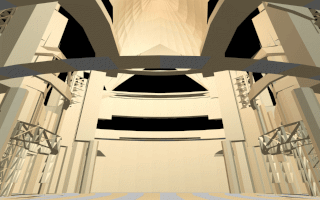
This tool is, in fact, a "design of species", and we can use it as an artificial
DNA to generate a multiplicity of architectural or environmental possible events.
It is based on a presumed homology between natural and artificial spheres, and
their belonging to the world of chaotic systems. Following possible consonances
between natural and artificial evolution systems, we can think that, like the DNA in
nature, we can assign to the "design of morphogenesis" the power to control the
evolution procedures and to define the complexity of possible meanings/prestations,
the stratification of multiple orders, the mode of contamination between orders and
between different
disciplinary fields, and, shortly, the recognisability of every events the system can
generate, apart from the subjective identity of every one.
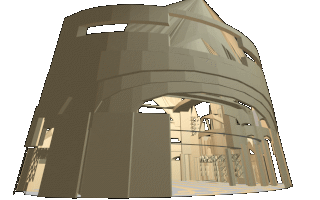
Topically, the creativity of the designer has been connected with the variation
of unpredictable subjective and cultural approach to the development of the
artificial environment. And this system has been simulated with the progressive
stratification of new points of view, generated by the unpredictable resonance
Practically, we can design the morphogenetic codes of an environment that, in the
meantime is growing up. The environmental design, as design of species, can directly
operate the dynamic flowing of the system, identifying the sensitive parameters with
the simulation of a connected sequence of possible scenarios.
Generating a universe of possible virtual realities we can design considering
some difficult topics like the dynamic saving of differences that become everyday
more important in front of the homologation of the increasingly international and
interdependent world.
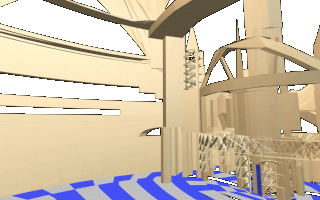
Every morphogenetical project is a subjective metadesign for the reason that it
is not an optimized arrangement but a system that can generate a lot of possible
parallel scenarios. We can manage the evolution of this project not changing the
final arrangement but operating on the parameters of the evolution code.
The evaluation of quality is the evaluation of the reliability in front of
unpredictable events and requests.
This type of reliability is typical of the living systems, and it is based on a
self-organizing process and on the continuous interchangeability of components.
In designing the simulation, two are the most important topics: The complexity
and the relationship between species and individual.
To manage the complexity I referred to the concept that the complexity is not
generable ex novo but only using a process to stratify sense into a flowing
simulation of a temporal irreversible path. We can activate and control this
stratification if we design a system with a self-organizing paradigm that can keep
sense, (practise) during the simulated time flowing.
To built this paradigm I referred to the chaotic dynamic systems that are
suitable to be controlled by algorithms, but that can produce ever different events.
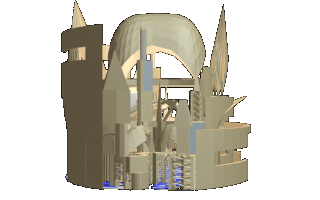
I have used a fractal but non deterministic logical frame. In other terms, every
decision cycle has inside, nidified, a lot of other cycles, and so on. The structure
of these cycles is, as in fractal objects, ever the same. The differences and the
unpredictability borns from the resonance with the other cycles, from the time of
activation and from the ever different flow of information.
Each cycle represents a whole structure in simulating the decision choices. It
operates the transformation of the answers into possible shapes. This device is
designed by:
1. The use of a paradigm to control the auto-organization procedures. This tool
represents and controls the gained complexity but, in the meantime, represent the
adaptivity to the incoming developments. It is the device that allows us to reply to
an answer putting one of the possible formal matrixes into the paradigm.
2. The identification and sharing of the random margins between answers and
shaping replies. The system uses and represents these margins as "operable fields"
for the designing choices to improve the project evolution.
3. The set of possible formal matrixes, that are abstract shapes but usable in
giving body to a set of possible performances. These formal matrixes are not a data
base. They are extemporary generated by the bound-up cycles, by a set of simultaneous
devices operating into a series of different fields, like geometry, dimension,
materials, technology, complexity, and so on.
Every formal matrix is, therefore, the extemporary production of the
contaminations and resonance into a set of different subsystems performed as a
following paradigm/random margin/formal matrix, in a subsequent omothetic complexity
that looks like a fractal shape.
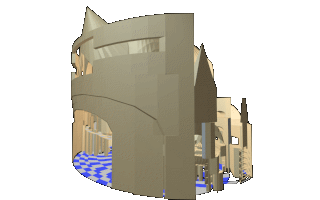
At the end of every cycle (and of the related and multiple progressive
nidifications) the result is:
1. An increasing complexity, and the related passage into a more evolved
representation of answers, and together the proliferation of the same answer.
2. The production of needs, for the reason that every event we design was born
also using subjective and random postures. It was not necessary before but it began
necessary after the choice: it is a part of the project history. This happens also if
we, later, remove it because we consider this event as an obsolete one. The event is
into the project history, and we can appreciate its contribution as time patina.
A time patina that measures the gained complexity, the growth of the specific
identity of the project, shaped by the past research occasions used as training
events.
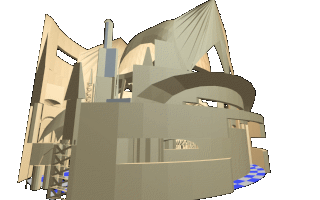
I have experimented these tools in many fields: the characterisation of
environmental shape in the medieval towns, and its relationship with the
contamination between natural and artificial events, the role of materials and
technologies in a historical town, a research about the possible new evolution of
modern environments like EUR, the evaluation of possible new identity of the suburbs,
the development of the natural/artificial environments like the valleys of Alps, the
contamination between nature and
architecture in the towns in front to the sea.
More, in the field of architecture, the experimentation on materials, like the
new possibility given by the steel components production, on technology innovations
and on component approach in building industrialisation
All these experimentation opportunities have remained in the project/software as
a progressive stratification of complexity. I updated my projects not changing one
algorithm with a more peculiar one, but redefining the possible field of the past
ones and inserting the new one as a new possible point of view that can live
together.
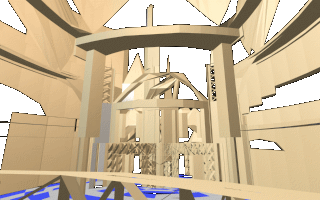
Like all scientific experimentations, I used the progressive falsifications and
not the linear deterministic paths. I have improved my research with progressive
attempts in variation of the parameters and in using new morphogenetic algorithms in
cathalizing the global process. Every effort has been never entirely negative or
affirmative. And so we can stratify it, according to the reduction of its possibility
to trust the evolution.
This research procedure has improved my experimental tools with the
representation of the multiplicity of possible paths to gain the complexity, with a
set of interconnected frames of possible orders. The parallel refining of the
mathematical models of the evolution paradigms has gone together with the progressive
flowing from subjective to inter-subjective credibility.
But, furthermore, this experimentation improves our reflections on the
extraordinary path of the designing ideas, on the possible explicitness of the idea
in architectural events, on the possibility, for every designer, to tell, perhaps,
ever the same fable, but ever different and more rich, improved and shaped by the
unpredictability of ever new hearers.
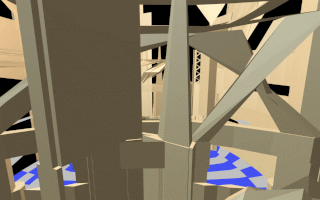
The Authors
Bibliography
Return to the first page
Mail to Prof. Celestino Soddu
 In this image, the sequence of the 3D architectural models are automatically generated using my Genetic Design Software. Every model is different but belongs to the same genetic code, to the same genetic IDEA.
In this image, the sequence of the 3D architectural models are automatically generated using my Genetic Design Software. Every model is different but belongs to the same genetic code, to the same genetic IDEA.
 (This image, and the others that follow, show one of the 3Dmodel automatically
generated using the morpho-genetic design software BASILICA)
(This image, and the others that follow, show one of the 3Dmodel automatically
generated using the morpho-genetic design software BASILICA)






